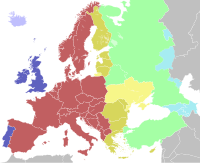
Photo from wikipedia
In the Internet of Things scene, the wireless sensor network (WSN) is widely used to monitor and perceive various context environments. The efficient utilization of time division multiple access (TDMA)… Click to show full abstract
In the Internet of Things scene, the wireless sensor network (WSN) is widely used to monitor and perceive various context environments. The efficient utilization of time division multiple access (TDMA) slot resource has attracted more and more attention, especially for applications with high network performance requirements, for example, vehicular networks. The characteristics of the WSN, which have limited battery volume and variable topology structure, restrict the development of the centralized time slot allocation algorithm. Moreover, the traditional distributed time slot allocation algorithm is helpless to reduce the energy consumption, even if the variable topology is solved to some extent. In this paper, we propose the distributed TDMA scheduling algorithm based on exponential backoff rule and energy-topology factor, namely EB-ET-distributed randomized (DRAND) algorithm. We analyze the typical DRAND time slot assignment algorithm and the distributed TDMA slot scheduling algorithm based on energy-topology factor, which is proposed in our another work. By introducing the idea of Lamport’s bakery algorithm, the priority control algorithm based on exponential backoff rules and energy-topology factor are presented to appropriately adjust the priority of time slot allocation and greatly reduce the probabilities of message collision and time slot allocation failure. Then, we introduce the implementation processes of the EB-ET-DRAND scheduling algorithm in various different states. The time slot structure and frame formats of algorithm are designed in detail. Finally, we implement a mesh network simulation system to evaluate the performance of proposed scheme. The experimental results indicate that the EB-ET-DRAND scheduling algorithm greatly improves the performance of time slot allocation and reduces the message complexity, time complexity, and energy consumption.
Journal Title: IEEE Access
Year Published: 2017
Link to full text (if available)
Share on Social Media: Sign Up to like & get
recommendations!